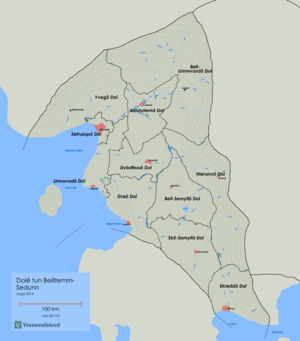Administrative divisions of Sedunn (Pacifica)
Since the administrative reform of 2014 Sedunn has three levels of administrative divisions. The territory is divided into twelve provinces (Sedunnic: dolē), which are further divided into 297 municipalities (tavvasa'lē) and 2541 districts (ovutlē). The provinces are self-governing local authorities responsible for providing advanced public health care, public transportation and regional development. The municipalities have local self-governing authority and are the main welfare providers. They also provide emergency services, public social services, sanitation and urban and rural planning. The purpose of the districts is population registration, including civil registration of births, marriages, civil partnerships and deaths, and for the collation of census information.
Furthermore, all provinces belong to one of the six so-called authority coordination regions (Sedunnic: stoveaffulsaflē (SES)). Various authorities such as those for military and civilian defence or energy use these to coordinate and delegate planning and daily work.
There are eleven historical counties (Sedunnic: haenlē) that still are important in culture. The counties are still recognised officially, but since the latest administrative reform all real duties were assumed by the new provinces which were designed to have a more equal population distribution. Culturally, Sedunn is also divided into Beilltemm-Sedunn (Bailtem-Sedunn) for the lands located in Bailtem and the overseas territory of Vastraenn in Keyli.
Provinces
The province is the top-level administrative level of Sedunnic territory. The provinces were created in 2014 in attempt to achieve a division with more equal populations than the old counties had. For example, the smallest county Deriess had a population of 125,000 while the most populous, Servelann, had over 4 million inhabitants. Excluding Vastraenn, the province with the lowest population is now Yveg with 1,025,000 inhabitants, while the most populous one is Setrusop with a population of 2,337,500. The borders of the provinces are based on the old counties to large degree.
The provinces are self-governing local authorities responsible for providing advanced public health care, public transportation and regional development.
